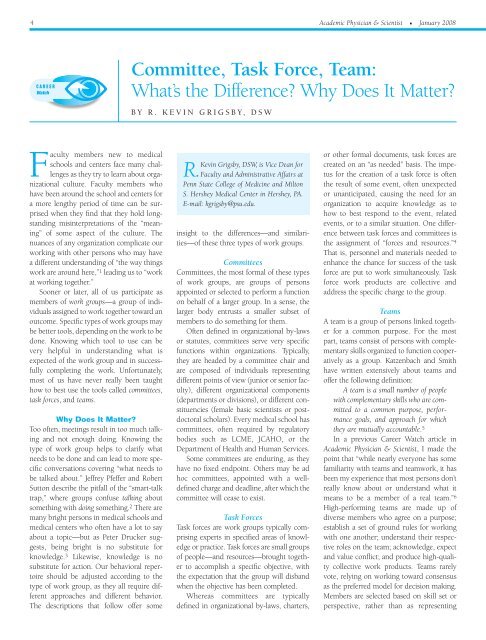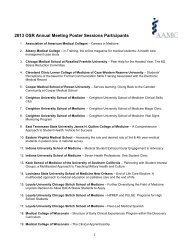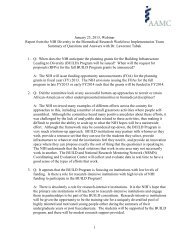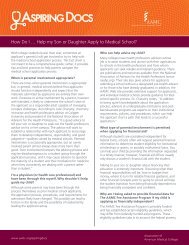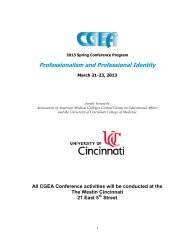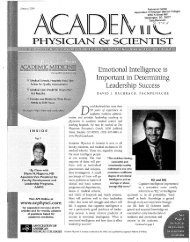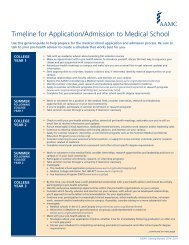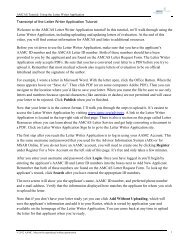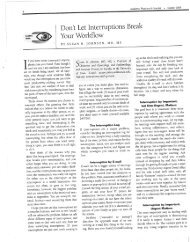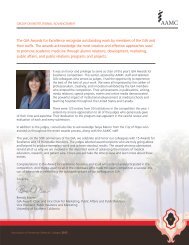Committee, Task Force, Team: What's the Difference? Why ... - AAMC
Committee, Task Force, Team: What's the Difference? Why ... - AAMC
Committee, Task Force, Team: What's the Difference? Why ... - AAMC
You also want an ePaper? Increase the reach of your titles
YUMPU automatically turns print PDFs into web optimized ePapers that Google loves.
4 Academic Physician & Scientist ■ January 2008<br />
CAREER<br />
Watch<br />
Faculty members new to medical<br />
schools and centers face many challenges<br />
as <strong>the</strong>y try to learn about organizational<br />
culture. Faculty members who<br />
have been around <strong>the</strong> school and centers for<br />
a more lengthy period of time can be surprised<br />
when <strong>the</strong>y find that <strong>the</strong>y hold longstanding<br />
misinterpretations of <strong>the</strong> “meaning”<br />
of some aspect of <strong>the</strong> culture. The<br />
nuances of any organization complicate our<br />
working with o<strong>the</strong>r persons who may have<br />
a different understanding of “<strong>the</strong> way things<br />
work are around here,” 1 leading us to “work<br />
at working toge<strong>the</strong>r.”<br />
Sooner or later, all of us participate as<br />
members of work groups—a group of individuals<br />
assigned to work toge<strong>the</strong>r toward an<br />
outcome. Specific types of work groups may<br />
be better tools, depending on <strong>the</strong> work to be<br />
done. Knowing which tool to use can be<br />
very helpful in understanding what is<br />
expected of <strong>the</strong> work group and in successfully<br />
completing <strong>the</strong> work. Unfortunately,<br />
most of us have never really been taught<br />
how to best use <strong>the</strong> tools called committees,<br />
task forces, and teams.<br />
<strong>Why</strong> Does It Matter?<br />
Too often, meetings result in too much talking<br />
and not enough doing. Knowing <strong>the</strong><br />
type of work group helps to clarify what<br />
needs to be done and can lead to more specific<br />
conversations covering “what needs to<br />
be talked about.” Jeffrey Pfeffer and Robert<br />
Sutton describe <strong>the</strong> pitfall of <strong>the</strong> “smart-talk<br />
trap,” where groups confuse talking about<br />
something with doing something. 2 There are<br />
many bright persons in medical schools and<br />
medical centers who often have a lot to say<br />
about a topic—but as Peter Drucker suggests,<br />
being bright is no substitute for<br />
knowledge. 3 Likewise, knowledge is no<br />
substitute for action. Our behavioral repertoire<br />
should be adjusted according to <strong>the</strong><br />
type of work group, as <strong>the</strong>y all require different<br />
approaches and different behavior.<br />
The descriptions that follow offer some<br />
<strong>Committee</strong>, <strong>Task</strong> <strong>Force</strong>, <strong>Team</strong>:<br />
What’s <strong>the</strong> <strong>Difference</strong>? <strong>Why</strong> Does It Matter?<br />
BY R. KEVIN GRIGSBY, DSW<br />
R. Kevin Grigsby, DSW, is Vice Dean for<br />
Faculty and Administrative Affairs at<br />
Penn State College of Medicine and Milton<br />
S. Hershey Medical Center in Hershey, PA.<br />
E-mail: kgrigsby@psu.edu.<br />
insight to <strong>the</strong> differences—and similarities—of<br />
<strong>the</strong>se three types of work groups.<br />
<strong>Committee</strong>s<br />
<strong>Committee</strong>s, <strong>the</strong> most formal of <strong>the</strong>se types<br />
of work groups, are groups of persons<br />
appointed or selected to perform a function<br />
on behalf of a larger group. In a sense, <strong>the</strong><br />
larger body entrusts a smaller subset of<br />
members to do something for <strong>the</strong>m.<br />
Often defined in organizational by-laws<br />
or statutes, committees serve very specific<br />
functions within organizations. Typically,<br />
<strong>the</strong>y are headed by a committee chair and<br />
are composed of individuals representing<br />
different points of view (junior or senior faculty),<br />
different organizational components<br />
(departments or divisions), or different constituencies<br />
(female basic scientists or postdoctoral<br />
scholars). Every medical school has<br />
committees, often required by regulatory<br />
bodies such as LCME, JCAHO, or <strong>the</strong><br />
Department of Health and Human Services.<br />
Some committees are enduring, as <strong>the</strong>y<br />
have no fixed endpoint. O<strong>the</strong>rs may be ad<br />
hoc committees, appointed with a welldefined<br />
charge and deadline, after which <strong>the</strong><br />
committee will cease to exist.<br />
<strong>Task</strong> <strong>Force</strong>s<br />
<strong>Task</strong> forces are work groups typically comprising<br />
experts in specified areas of knowledge<br />
or practice. <strong>Task</strong> forces are small groups<br />
of people—and resources—brought toge<strong>the</strong>r<br />
to accomplish a specific objective, with<br />
<strong>the</strong> expectation that <strong>the</strong> group will disband<br />
when <strong>the</strong> objective has been completed.<br />
Whereas committees are typically<br />
defined in organizational by-laws, charters,<br />
or o<strong>the</strong>r formal documents, task forces are<br />
created on an “as needed” basis. The impetus<br />
for <strong>the</strong> creation of a task force is often<br />
<strong>the</strong> result of some event, often unexpected<br />
or unanticipated, causing <strong>the</strong> need for an<br />
organization to acquire knowledge as to<br />
how to best respond to <strong>the</strong> event, related<br />
events, or to a similar situation. One difference<br />
between task forces and committees is<br />
<strong>the</strong> assignment of “forces and resources.” 4<br />
That is, personnel and materials needed to<br />
enhance <strong>the</strong> chance for success of <strong>the</strong> task<br />
force are put to work simultaneously. <strong>Task</strong><br />
force work products are collective and<br />
address <strong>the</strong> specific charge to <strong>the</strong> group.<br />
<strong>Team</strong>s<br />
A team is a group of persons linked toge<strong>the</strong>r<br />
for a common purpose. For <strong>the</strong> most<br />
part, teams consist of persons with complementary<br />
skills organized to function cooperatively<br />
as a group. Katzenbach and Smith<br />
have written extensively about teams and<br />
offer <strong>the</strong> following definition:<br />
A team is a small number of people<br />
with complementary skills who are committed<br />
to a common purpose, performance<br />
goals, and approach for which<br />
<strong>the</strong>y are mutually accountable. 5<br />
In a previous Career Watch article in<br />
Academic Physician & Scientist, I made <strong>the</strong><br />
point that “while nearly everyone has some<br />
familiarity with teams and teamwork, it has<br />
been my experience that most persons don’t<br />
really know about or understand what it<br />
means to be a member of a real team.” 6<br />
High-performing teams are made up of<br />
diverse members who agree on a purpose;<br />
establish a set of ground rules for working<br />
with one ano<strong>the</strong>r; understand <strong>the</strong>ir respective<br />
roles on <strong>the</strong> team; acknowledge, expect<br />
and value conflict; and produce high-quality<br />
collective work products. <strong>Team</strong>s rarely<br />
vote, relying on working toward consensus<br />
as <strong>the</strong> preferred model for decision making.<br />
Members are selected based on skill set or<br />
perspective, ra<strong>the</strong>r than as representing
Academic Physician & Scientist ■ January 2008 5<br />
some component or constituency of <strong>the</strong><br />
organization. Although <strong>the</strong>re may be a designated<br />
leader, leadership moves from<br />
member to member based on <strong>the</strong> topic or<br />
task assigned and <strong>the</strong> member’s skills.<br />
Successful teamwork requires members to<br />
behave in ways allowing work toward a collective<br />
product.<br />
An Example from<br />
Academic Medicine<br />
A common academic function is <strong>the</strong> process<br />
of recognition and reward by promotion<br />
through <strong>the</strong> professorial ranks. <strong>Committee</strong>s,<br />
task forces, and teams might all have a role in<br />
<strong>the</strong> promotion process, as shown below.<br />
The <strong>Committee</strong><br />
Most of us are familiar with <strong>the</strong> role of <strong>the</strong><br />
promotion committee, although it may be<br />
labeled differently in different organizations.<br />
The creation of <strong>the</strong> committee is a result of<br />
<strong>the</strong> college or university by-laws, statutes, or<br />
policies and is required in every academic<br />
department and college within <strong>the</strong> university.<br />
By definition, <strong>the</strong> committee is responsible<br />
for rendering decisions. The group of<br />
senior faculty members, led by an appointed<br />
or elected chairperson, review carefully prepared<br />
dossiers of faculty being considered<br />
for promotion and discuss or deliberate<br />
about <strong>the</strong> qualifications and performance of<br />
candidates. <strong>Committee</strong>s most often render a<br />
decision by voting. Following <strong>the</strong> vote, <strong>the</strong><br />
committee chair prepares a letter or letters<br />
revealing <strong>the</strong> outcome of <strong>the</strong> committee<br />
vote. In many systems, those letters become<br />
a part of <strong>the</strong> dossier.<br />
The <strong>Task</strong> <strong>Force</strong><br />
Say that during recent promotion committee<br />
deliberations, members noticed a precipitous<br />
decline in <strong>the</strong> quality of dossiers<br />
submitted on behalf of junior faculty members.<br />
Many promotion committee members<br />
feel that <strong>the</strong> declining quality of dossiers is<br />
evidence of <strong>the</strong> need for change.<br />
In response, a task force composed of<br />
experts in <strong>the</strong> areas of faculty development,<br />
academic promotion, and university promotion<br />
policies is appointed to explore options<br />
for improving <strong>the</strong> process for developing<br />
junior faculty members. The charge to <strong>the</strong><br />
task force is to review policies and programs<br />
at o<strong>the</strong>r medical schools and to report on<br />
how your school can have state-of-<strong>the</strong>-art<br />
“Our behavioral repertoire should be<br />
adjusted according to <strong>the</strong> type of work<br />
group, as <strong>the</strong>y all require different<br />
approaches and different behavior.”<br />
faculty development services by <strong>the</strong> beginning<br />
of <strong>the</strong> next promotion cycle. The task<br />
force report will need to include a strategy,<br />
operational plan, and related budget.<br />
The <strong>Team</strong><br />
Assume that recent deliberations by <strong>the</strong> college<br />
promotion committee found a precipitous<br />
decline in <strong>the</strong> quality of dossiers submitted<br />
on behalf of junior faculty members.<br />
In turn, a review of faculty hiring revealed a<br />
high turnover rate for junior faculty members.<br />
Exit interview findings indicate that<br />
junior faculty members do not feel supported<br />
by department chairs and senior faculty,<br />
and dossiers of junior faculty members<br />
reflect a decline in scholarly productivity.<br />
Based on a report from <strong>the</strong> task force on<br />
faculty development and promotion, a<br />
“career enhancement team” is formed to<br />
support junior faculty. The team consists of<br />
physicians with skills in <strong>the</strong> area of mentoring,<br />
basic scientists who have a track record<br />
of successfully mentoring junior faculty,<br />
junior faculty members involved in <strong>the</strong> promotion<br />
process, senior faculty members<br />
with a historical view of promotion of faculty<br />
over time, an expert in employment benefits<br />
and policies, a human resources<br />
department member, and o<strong>the</strong>r faculty<br />
members who are well-published in <strong>the</strong> area<br />
of faculty development.<br />
<strong>Team</strong> members agree to hold each o<strong>the</strong>r<br />
accountable, to embrace conflict and make it<br />
work for <strong>the</strong> team, and to produce a program<br />
plan, design, and budget (a collective<br />
work product) within <strong>the</strong> next 90 days. As<br />
interdependent team players, <strong>the</strong> members<br />
subordinate <strong>the</strong>ir individual desired outcomes<br />
as <strong>the</strong>y work toward consensus as to<br />
<strong>the</strong> best approaches to supporting junior faculty<br />
members in pursuit of promotion. The<br />
team creates and implements a state-of-<strong>the</strong>art<br />
faculty development service before <strong>the</strong><br />
beginning of <strong>the</strong> next promotion cycle. The<br />
report from <strong>the</strong> task force provides <strong>the</strong> strategy,<br />
operational plan, and related budget.<br />
No One Said It Would Be Easy<br />
Undoubtedly, <strong>the</strong>re are committees that<br />
should be task forces or teams, task forces<br />
that should be committees or teams, and<br />
teams that probably should be committees<br />
or task forces. Even if <strong>the</strong> right type of group<br />
is appointed and <strong>the</strong> members are clear<br />
about <strong>the</strong> charge, <strong>the</strong>re are plenty of opportunities<br />
for becoming mired in <strong>the</strong> work<br />
itself. <strong>Team</strong>s are well suited for many of <strong>the</strong><br />
complex, system-oriented problems we all<br />
encounter in medical schools and health<br />
centers. However, even if a team approach is<br />
appropriate, organizational change in medical<br />
schools and health centers can be slow.<br />
In recent times, <strong>the</strong>re has been much greater<br />
interest in <strong>the</strong> team approach across a wide<br />
range of organizations. I believe we will see<br />
this organizational form adopted more often<br />
in medical schools and medical centers as<br />
we move into <strong>the</strong> future, but committees<br />
and task forces still serve—and likely will<br />
serve—useful functions and should be used<br />
as <strong>the</strong> “best tool for <strong>the</strong> job.” ❖<br />
References<br />
1. Bower JL. The Will to Manage: Corporate Success<br />
through Programmed Management. New York:<br />
McGraw-Hill, 1966.<br />
2. Pfeffer J, Sutton RI. The smart-talk trap. Harvard<br />
Bus Rev May–June 1999: 134–142.<br />
3. Drucker PF. The Essential Drucker. New York:<br />
HarperCollins, 2003:220.<br />
4. Webster’s II New Riverside University Dictionary.<br />
Boston: Houghton Mifflin, 1988.<br />
5. Katzenbach JR, Smith DK. The Wisdom of <strong>Team</strong>s:<br />
Creating <strong>the</strong> High Performance Organization.<br />
Boston: Harvard Business School Press, 1993.<br />
6. Grigsby RK. Are you really a team player?<br />
Academic Physician and Scientist. July–August<br />
2006: 4–5.<br />
For an expanded version of<br />
this article, including additional<br />
discussion, see <strong>the</strong> APS Web site<br />
at www.acphysci.com.


